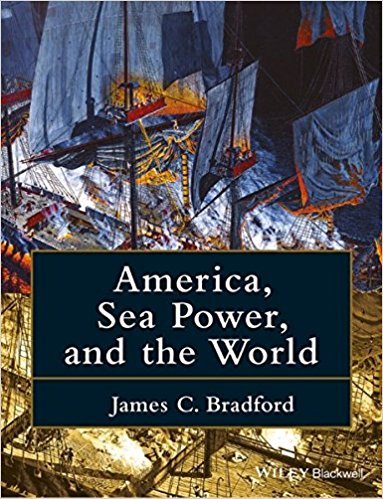America, Sea Power, and the World
Edited by James C. Bradford
 Although assessments of the rise of American preeminence on the seas are not few, James C. Bradford’s America, Sea Power, and the World is an impressive treatment of the important topic. Bradford, serving as editor for the work, has mustered an impressive array of naval historians for the task, and his skill as an editor has given the book a surprisingly smooth narrative quality. Most of the authors are affiliated with the United States Naval Academy, and their expertise in each chapter is clear. Across the numerous authors, one strand of argument is apparent: the course of American history is inseparably bound to the nation’s ability to innovate and project sea power. In advancing this thesis, the authors are overwhelmingly successful in providing a useful overview for experts and casual readers alike.
Although assessments of the rise of American preeminence on the seas are not few, James C. Bradford’s America, Sea Power, and the World is an impressive treatment of the important topic. Bradford, serving as editor for the work, has mustered an impressive array of naval historians for the task, and his skill as an editor has given the book a surprisingly smooth narrative quality. Most of the authors are affiliated with the United States Naval Academy, and their expertise in each chapter is clear. Across the numerous authors, one strand of argument is apparent: the course of American history is inseparably bound to the nation’s ability to innovate and project sea power. In advancing this thesis, the authors are overwhelmingly successful in providing a useful overview for experts and casual readers alike.
Bradford lays a useful base of naval history in the first chapter of the book. Though entirely predating the emergence of the United States as a sovereign nation, this chapter makes clear the connections between political power on land and sea power around the world. Once the book proceeds to its study of American sea power in particular, these early principles reappear in the close relationship between the fortunes of the nation and its navy. As the chapters progress throughout American history, no major naval episode is neglected, giving the topic sufficient coverage, even if certain areas are not explored to a sufficient depth for a specialist’s use. One of the book’s best contributions is “Defending Imperial Interests in Asia and the Caribbean, 1898-1941.” These oft-forgotten events are an important part of America’s naval story at the turn of the twentieth century, and the chapter’s author, Aaron B. O’Connell, lends the dense topic considerable clarity.
Bradford has dedicated more space to the American Civil War and World War II than to other American military struggles, but this understandably reflects the large body of scholarship already dedicated to these periods. America, Sea Power, and the World will work nicely in courses surveying American naval history and will appeal to students of varying levels of familiarity with the topic. One of the book’s great strengths is its readability amid technical topics, lending it a broad readership that will undoubtedly include people outside the typical scope of professional history. Some chapters also depart from the rigid chronological framework to discuss important technological trends that cross large time periods.
From beginning to end, America, Sea Power, and the World displays the unique history of American naval power at home and abroad. Despite the work’s breadth, each aspect of America’s naval history receives useful coverage. The book concludes with an exploration of the future of naval power in light of challenges to American hegemony. As Bradford’s book aptly proves, America must innovate in the midst of wearying change to maintain its position of leadership among ascendant powers.
- Chichester: John Wiley & Sons, 2016
- 7-1/2: x 9-1/2”, softcover, xxiii + 379 pages
- Illustrations, maps, tables, notes, bibliography, index. $39.95
- ISBN: 9781118927939
Reviewed by Austin Croom, East Carolina University
